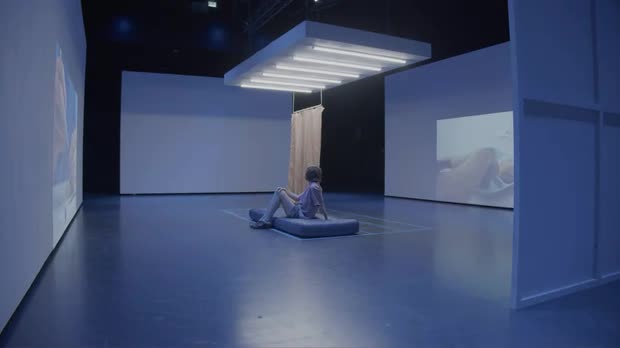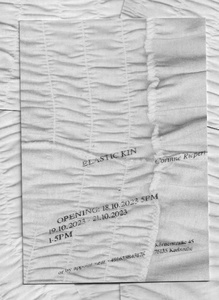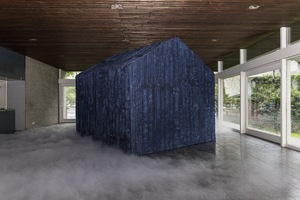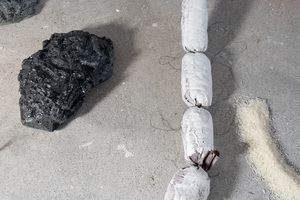"Installation"
| Begriff | Installation |
| Metakey | Schlagworte (madek_core:keywords) |
| Typ | Keyword |
| Vokabular | Madek Core |
4 Inhalte
- Seite 1 von 1
7QM
- Titel
- 7QM
- Titel (en)
- 7sqm - inside views
- Untertitel
- Innen(an)sichten
- Autor/in
- Beschreibung (de)
- Was passiert, wenn Individuen in engen, geschlossenen Räumen mit kaum persönlicher, sondern standardisierter, fest verankerter, textilloser Ausstattung leben, in denen sie einer permanenten Überwachung und Kontrolle sowie streng geregelten Tagesabläufen ausgesetzt sind?
Mascha Dilger untersucht die Parameter sanktionierender Räume: Besuche in unterschiedlichen Justizvollzugsanstalten und Interviews mit ehemaligen Inhaftierten werden in der Rauminstallation 7qm - Innen(an)sichten verarbeitet. Realitäten eines vor der Gesellschaft verborgenen und von ihr verdrängten Ortes werden offengelegt.
Die Arbeit beleuchtet, wie aus einem fremdbestimmten, rasterartigen Alltag einer totalen Institution, Versuche der geistigen Flucht und der Selbstbestimmtheit hervorgehen können. Es werden ortsspezifische und subkulturelle Erscheinungsformen betrachtet, die als Überlebensstrategien zu verstehen sind.
- Was passiert, wenn Individuen in engen, geschlossenen Räumen mit kaum persönlicher, sondern standardisierter, fest verankerter, textilloser Ausstattung leben, in denen sie einer permanenten Überwachung und Kontrolle sowie streng geregelten Tagesabläufen ausgesetzt sind?
- Beschreibung (en)
- What happens when individuals live in narrow, confined spaces with hardly any personal but standardized, firmly anchored, textile-less furnishings, in which they are exposed to permanent surveillance and control as well as strictly regulated daily routines?
Mascha Dilger investigates the parameters of sanctioning spaces: visits to various prisons and interviews with former inmates are processed in the spatial installation "7qm - Innen(an)sichten". Realities of a place hidden from society are revealed.
The work illuminates how attempts of mental escape and self-determination can emerge from the grid-like everyday life of a total institution. Site-specific and subcultural manifestations are considered, which are to be understood as survival strategies.
- What happens when individuals live in narrow, confined spaces with hardly any personal but standardized, firmly anchored, textile-less furnishings, in which they are exposed to permanent surveillance and control as well as strictly regulated daily routines?
- Kategorie
- Typ des Projekts/Werks
- Schlagworte
- Datierung
- 11.07.2023 - 12.07.2023
- Mitwirkende
- Dank an
- Zaur Ahlimanov
- Phillip Banian
- Jeremias Beckford
- Sandra Blatterer
- Barbara Bohnen
- Matthias Bruhn
- Richard Brunner
- Céline Condorelli
- Hannah Cooke
- Jaya Demmer
- Lina Determann
- Alfred Dilger
- Nicola Dilger
- Susanne Dilger
- Manfred Döpke
- Nina Eberle
- Kerstin Eisenmenger
- Constanze Fischbeck
- Ebba Fransén Waldhör
- Laura Haak
- Uwe Habel
- Laurine Haller
- Igor Hardt
- Lina Höhne
- Lovis Iglinski
- Martina Kaltenbrunner
- Tobias Keilbach
- Alexander Knoppik
- Katja Koch
- Mikail Kolbasar
- Hanne König
- Susanne Kriemann
- Claudia Kröhl
- Barbara Kuon
- Alexia Metge
- Paulina Mimberg
- Ilja Morgenstern
- Leonie Mühlen
- Minh Anh Nguyen
- Luise Peschko
- Milena Petrovic
- Vlado Petrovic
- Tibor Pilz
- Paul Platz
- Christian Platz
- Waldemar Präg
- Corinne Riepert
- Thomas Rustemeyer
- Sebastian Schäfer
- Max Schäffer
- Philipp Schell
- Susanne Schmitt
- Mischa Schneider
- Waldemar Schwab
- Henriette Schwabe
- Manuel Sékou
- Alexander Theis
- Alexander Thelen
- Jan Tölle
- Lisa Tölle
- Lioudmila Voropai
- JVA Mannheim
- JVA Bühl
- Exit - Enter Life e.V.
- Badaue
- AStA
- Initiative „Faites Votre Jeu!“
- Sprache
- Material
- Ort: Institution
- Ort
- im großen Studio
- Stadt
- Land
- Beteiligte Institution(en)
- Titel
- 7QM
- Projektleiter/in
- Semester
- Studiengang
- Typ der Abschlussarbeit
- Importiert am
- 26.07.2023
- Übergeordnete Sets
- 1
- Set enthält
- 4 2
Elastic Kin
- Titel
- Elastic Kin
- Autor/in
- Beschreibung (de)
- Die Rauminstallation “Elastic Kin” zeigt eine Gruppe von Textilobjekten - Gefüge -, die aus weggeworfenen Kleidungsstücken bestehen. Sie existieren sowohl als Individuen als auch als Gruppe. Die Kleidungsstücke, die in den Straße von K. gefunden wurden und von Anderen in anderen Kontext hergestellt worden sind, kehren ihren ursprünglichen Zweck um, indem sie zu eigenen Körpern werden, die unabhängig von menschlichen Körpern sind. Jede Oberfläche ist wie eine geheime Landkarte, die Spuren anonymer Hände enthält, die an den Textilien gearbeitet haben.
Der Sound der Installation ist ein Echo - fast verschwundener, kollektiver Erinnerungen an vergangene Momente und Orte.
“Elastic Kin” versucht, eine weit verbreitete Verwandtschaft darzustellen, die durch unsichtbare, lose und elastische Fäden imaginiert wird, die ein internationales System von Lieferketten, Arbeiter*Innen und Konsument*Innen, Trendprognosen und unvorhersehbarem Zeitgeist, Massenproduktion und meditativer Handarbeit abbilden. Welche Spuren dieser Kontexte enthalten die Kleidungsstücke?
Das Video zeigt eine performative Intervention im öffentlichen Raum. Es zeigt die Gefüge, die eine neue Existenz außerhalb ihrer Produktions- und Vermarktungskontexte führen: Sie kehren in ein Einkaufszentrum zurück, animiert von den Menschen, die sie einst bekleideten.
- Die Rauminstallation “Elastic Kin” zeigt eine Gruppe von Textilobjekten - Gefüge -, die aus weggeworfenen Kleidungsstücken bestehen. Sie existieren sowohl als Individuen als auch als Gruppe. Die Kleidungsstücke, die in den Straße von K. gefunden wurden und von Anderen in anderen Kontext hergestellt worden sind, kehren ihren ursprünglichen Zweck um, indem sie zu eigenen Körpern werden, die unabhängig von menschlichen Körpern sind. Jede Oberfläche ist wie eine geheime Landkarte, die Spuren anonymer Hände enthält, die an den Textilien gearbeitet haben.
- Beschreibung (en)
- The spatial installation “Elastic Kin” shows a group of textile objects – Gefüge – that were assembled from discarded and abandoned garments. They exist as individuals as well as a kin. Assembled from used garments, found in the streets of K., produced by others in other contexts, they invert their original purpose by becoming bodies of their own, no longer dependent on being activated by a human body. The surface of every Gefüge is like a secret map, containing traces of anonymous hands working on them.
The sound in the installation is an echo of almost vanished collective memories of past moments and places. “Elastic Kin” attempts to depict a widespread kinship, that is imagined through invisible, loose and elastic threads mapping an international system of supply chains, workers and consumers, trend forecast and unpredictable zeitgeist, mass production and meditative handcraft. Which traces of these contexts do the garments contain?
The video shows a performative intervention in pub- lic space. It shows the Gefüge leading a new existence outside their production and marketing contexts: They return to the shopping mall, animated by the people, they once used to dress.
- The spatial installation “Elastic Kin” shows a group of textile objects – Gefüge – that were assembled from discarded and abandoned garments. They exist as individuals as well as a kin. Assembled from used garments, found in the streets of K., produced by others in other contexts, they invert their original purpose by becoming bodies of their own, no longer dependent on being activated by a human body. The surface of every Gefüge is like a secret map, containing traces of anonymous hands working on them.
- Typ des Projekts/Werks
- Schlagworte
- Datierung
- 18.10.2023
- Mitwirkende
- Dank an
- Sprache
- Untertitel (Film)
- Material
- Ort: Institution
- Stadt
- Land
- Titel
- Elastic Kin
- Projektleiter/in
- Semester
- Studiengang
- Typ der Abschlussarbeit
- Importiert am
- 02.11.2023
- Übergeordnete Sets
- 1
- Set enthält
- 0 22
“I see” “with my voice”
- Titel
- “I see” “with my voice”
- Autor/in
- Beschreibung (de)
- „I see“ „with my voice“ beschäftigt sich mit Themen wie Transformation, Gestaltwandel und Materialität durch ein Zusammenspiel von literarischen Fragmenten und entliehenen Stimmen. Das Ergebnis ist eine nicht-lineare, fluide Erzählung, die die flüchtige Natur von Visionen, Träumen und Metamorphosen einfängt.
- Beschreibung (en)
- “I see” “with my voice” engages with themes of transformation,
shapeshifting, and materiality through an interplay of literary
fragments and borrowed voices, resulting in a non-linear, fluid
narrative that encapsulates the ephemeral nature of visions,
dreams, and metamorphoses.
This project draws substantial inspiration from Alice Notley's
The Descent of Alette, a transformative odyssey that employs
rhythmic spoken language to explore continuous change.
Alongside Notley’s influence, the works of Hildegard von Bingen,
a 12th-century mystic, and the visionary narratives from the
biblical book of Ezekiel, serve as foundational texts that inform
the thematic and structural framework of this piece.
The text is presented as an audio recording, whispered as a 20 minute loop.
Visitors can listen to the piece when pressing their ear against the tents walls.
My objects are performers, maybe even imposters: frozen in a state of change or mimicry. My objects are performers, maybe even imposters: frozen in a state of change or mimicry.
They are skillfull imitators, but you can tell something is off.
Moving along this crack between the believable and the not quite right, I like to engage
with different realities and states of being. The artificial, almost real-life fakeness of their with different realities and states of being. The artificial, almost real-life fakeness of their
surfaces set the stage for my narrative of transformation, imitation and shapeshifting.
1. A wooden house crafted from smooth denim. Made by sanding the grain of wood
onto the denim fabric
2. Heavy fog covering the floor that could be perceived as dew, mixed with a light subtle
smoke of Incense burning.
The fragrance envokes sacred, holy feelings with its warm, resinous smell with peppery The fragrance envokes sacred, holy feelings with its warm, resinous smell with peppery
undertones.
3. 100 cherries made from a thick mixture of honey and almonds. The heavy sweetness
of the stoneless candy-imposter meant to linger in the visitors mouth as it is tasted. of the stoneless candy-imposter meant to linger in the visitors mouth as it is tasted.
A thin gelatine film – imitating the coolnes of cherry skin as it touches the lips A thin gelatine film – imitating the coolnes of cherry skin as it touches the lips
The installation is accompanied by a small reader containing the three part text to be taken The installation is accompanied by a small reader containing the three part text to be taken
home and serve as a keep sake or document of the fleeting spoken text.
The reader is bound with one simple staple. It does not have a beginning or end, but The reader is bound with one simple staple. It does not have a beginning or end, but
rather works like a gif. No cover or back. Just like wheels turning endlessly in a nonlinear rather works like a gif. No cover or back. Just like wheels turning endlessly in a nonlinear
storytelling.
- “I see” “with my voice” engages with themes of transformation,
- Kategorie
- Typ des Projekts/Werks
- Schlagworte
- Datierung
- 18.04.2024
- Sprache
- Ort: Institution
- Ort
- “I see” “with my voice” at ZKM Pavillon, Karlsruhe
- Stadt
- Land
- Titel
- “I see” “with my voice”
- Projektleiter/in
- Semester
- Studiengang
- Typ der Abschlussarbeit
- Importiert am
- 19.09.2024
- Übergeordnete Sets
- 0
- Set enthält
- 0 2
Ghost Story
- Titel
- Ghost Story
- Autor/in
- Beschreibung (en)
- The project was born in response to the passing of an unaccompanied homeless individual in 2018, a person without known family or friends. Her death was cataloged—reduced to data archived in newsrooms and on digital servers. Yet, if this data remains untouched, and her memory fades into obscurity, does her existence persist? She lingers and remains unseen—a paradoxical state of both presence and absence. Within the digital void, she exists as a spectral trace, haunting the silence, waiting to be rediscovered, forever closed in on herself.
Such is the nature of ghosts—the living create them. We resurrect the departed in our own ways, through rituals, texts, and the intangible recipes of memory. We read, we create, we consume, and through this, we invite the dead to inhabit us once more. This project is an assemblage of fragments—an exploration of the processes through which we become haunted by the past.
- The project was born in response to the passing of an unaccompanied homeless individual in 2018, a person without known family or friends. Her death was cataloged—reduced to data archived in newsrooms and on digital servers. Yet, if this data remains untouched, and her memory fades into obscurity, does her existence persist? She lingers and remains unseen—a paradoxical state of both presence and absence. Within the digital void, she exists as a spectral trace, haunting the silence, waiting to be rediscovered, forever closed in on herself.
- Kategorie
- Typ des Projekts/Werks
- Schlagworte
- Datierung
- 18.04.2024
- Dank an
- Sprache
- Material
- Ort
- Pförtnerhäuser, Alter Schlachthof
- Stadt
- Land
- Titel
- Ghost Story
- Projektleiter/in
- Semester
- Studiengang
- Typ der Abschlussarbeit
- Importiert am
- 25.09.2024
- Übergeordnete Sets
- 0
- Set enthält
- 0 9



